The new McLaren Senna is set to hit the market at the ultra-cool price of $1 million. The street-legal track car bears the name of legendary Formula 1 driver Ayrton Senna. Only 500 will be made.
The car features ultra-lightweight construction with carbon fiber chassis and body panels; a mid-mounted, twin-turbocharged V-8 McLaren engine; rear wheel drive; a race-derived suspension system; electro-hydraulic steering; and two seats.
Every body panel of the McLaren Senna is made from carbon fiber as the car weighs in at 2m641 pounds.
Powertrain
The 4-liter twin-turbocharged V-8 engine at the heart of the McLaren Senna is the most powerful road car internal combustion engine ever created by McLaren, producing 789 bhp and torque of 590 lb-ft. The engine’s dry sump lubrication and flat-plane crankshaft are technologies with their roots in motorsport. Lightweight internal components reduce mass in the powertrain and combine with ultra-low inertia, twin-scroll turbochargers and electronically controlled wastegates to deliver lightning-quick throttle responsiveness.
Those fortunate enough to drive the McLaren Senna will feel the cockpit come alive with the sound of air rushing into the roof-mounted snorkel intake and mixing in the carbon fiber plenum, producing high-frequency sounds, while the low-frequency hum continues from the engine.
A dual-clutch seven-speed gearbox delivers power to the rear wheels. A fully automatic mode is the default, with the driver able to choose full manual control of gear shifts via paddles mounted on a rocker behind the steering wheel. The elongated carbon fibre paddles are optimized to be used both with or without racing gloves.
The character of the 4-liter twin-turbo McLaren V-8 and the transmission can be tailored using the Active Dynamics Panel, with the driver having a choice of Comfort, Sport or Track powertrain modes. Whatever the mode throttle response is immediate and neck-snapping, pinning the driver back into their seat.
Suspension
RaceActive Chassis Control II (RCC II) hydraulic suspension works in harmony with front and rear active aerodynamics and the ultra-rigid Monocage III.
RCC II is a double-wishbone suspension system that additionally features hydraulically interconnected dampers and a hydraulic replacement for conventional mechanical anti-roll bars. It also further develops the variable stiffness and ride height technology first seen in the McLaren P1.
The adaptive dampers are interconnected hydraulically, both left to right and front to back, with two valves per damper to independently adjust for compression and rebound. The stiffness of the McLaren Senna is separately controlled using a kinetic roll system, or K-damper.
Wind Rider
Viewed from above, the body of the McLaren Senna looks like a teardrop, with body components clipped onto the cabin to deliver optimal aerodynamic performance.
The McLaren Senna introduces a new generation of front and rear active aerodynamics, raising downforce and aero control to a high level to ensure the performance potential can be fully exploited, according to the company.
Every element of the body design, from the front splitter to the double diffuser at the rear, has been developed to optimize downforce and aerodynamic balance, whether under braking, adjusting the throttle mid corner, or applying power on corner exit.
Cooling requirements played an equally crucial role in the overall design of the McLaren Senna: the rear clamshell, for example, was born from the twin demands of aerodynamic and cooling performance, with prominent gurney flaps ahead of a succession of stepped louvres directing air away from the rear deck and down the sides of the body. The resulting area of low pressure draws hot air out from the high-temperature radiators and engine bay, with the louvres ensuring that the airflow does not impact the efficiency of the rear wing.
The slash cut finishers of the Inconel and titanium exhaust exit through the lowest rear deck, the angle of the pipes directing exhaust gas away from the rear wing.
The slim, rear LED taillights have been subject to the same exacting attention to detail as the headlights and every other aero-relevant component, the single-blade design minimising interruptions to airflow.
The double diffuser at the rear of the car is unmistakable. Created as a single piece of carbon fiber, it begins under the rear axle and as it increases in height accelerates air out from under the vehicle. This creates a low-pressure zone that sucks the McLaren Senna even tighter to the ground. Equally noticeable is a huge, double-element carbon fiber rear wing that at its highest point sits 48 inches from the road when the car is stationary. Hydraulically actuated and with a planform surface area of more than 6,500cm2, the wing constantly adjusts to optimize the levels of downforce and aerodynamic balance and functions as an airbrake under heavy braking.
Interior
The cockpit environment reflects the stripped-back, functional nature that is evident in every aspect of the McLaren Senna. Visual carbon fiber is used extensively. Dependent on customer preference, Alcantara or leather covers the seats, facia and side airbags, but the absence of any other interior trim both saves weight and reveals the construction of the doors. Even the gas struts are exposed to save vital pounds.
Driver controls have been deliberately kept to a minimum to reduce cockpit clutter and the three-spoke steering wheel is free of buttons and switches, creating a pure focus on sensory feedback. All the information the driver needs comes from the high-definition McLaren Folding Driver Display and central infotainment screen.
The McLaren Senna will be hand-assembled in England at the McLaren Production Centre. Production will be limited to 500 vehicles, each costing from $1 million.
